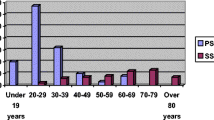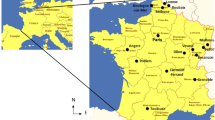Abstract
Background and Purpose
Primary spontaneous pneumothorax (PSP) tends to cluster. Previous studies have found a correlation between PSP and atmospheric pressure variations or thunderstorms. We conducted this study to analyze the PSP correlations with meteorological variables and the concentrations of air pollutants in the city of Cuneo in Italy (IT).
Methods
We evaluated prospectively 451 consecutive PSP patients treated between 2004 and 2010. For each day within the period analyzed, the meteorological parameters and pollutants data were recorded. Statistical analyses on PSP were done for distribution characteristics, spectral autocorrelation, and spectral analysis. Multivariate regression analyses were performed using artificial neural networks.
Results
Analysis of annual, seasonal, and monthly distributions showed no significant correlation between PSP and the time series. The spectral analysis showed that PSP events were not random. Correlations between meteorological and environmental variables confirmed that PSP was significantly more likely to occur on warm windy days with high atmospheric pressure and high mean nitrogen dioxide concentration.
Conclusions
Meteorological parameters and atmospheric pollutants might explain the cluster onset of PSP.


Similar content being viewed by others
References
Noppen M. Spontaneous pneumothorax: epidemiology, pathophysiology and cause. Eur Respir Rev. 2010;19:217–9.
Sahn SA, Heffner JE. Spontaneous pneumothorax. N Engl J Med. 2000;342:868–74.
Ozpolat B. Is the onset of spontaneous pneumothorax influenced by air pollution meteorological changes, or both? J Thorac Dis. 2012;2:1–4.
Noppen M, Verbanck S, Harvey J, Van Herreweghe R, Meysman M, Vincken W, Paiva M. Music: a new cause of primary spontaneous pneumothorax. Thorax. 2004;59:722–4.
Smit HJ, Devillé WL, Schramel FM, Schreurs JM, Sutedja TG, Postmus PE. Atmospheric pressure changes and outdoor temperature changes in relation to spontaneous pneumothorax. Chest. 1999;116:676–81.
Suarez-Varel MM, Martinez-Selva MI, Llopis-Gonzalez A, Martinez-Jimeno JL, Plaza-Valia P. Spontaneous pneumothorax related with climatic characteristics in the Valencia area (Spain). Eur J Epidemiol. 2000;16:193–8.
Bulajich B, Subotich D, Mandarich D, Vojnovich Kljajich R, Gajich M. Influence of atmospheric pressure, outdoor temperature, and weather phases on the onset of spontaneous pneumothorax. Ann Epidemiol. 2005;15:185–90.
Alifano M, Forti Parri SN, Bonfanti B, Arab WA, Passini A, Boaron M, Roche N. Atmospheric pressure influences the risk of pneumothorax: beware of the Storm! Chest. 2007;131:1877–82.
Bertolaccini L, Alemanno L, Rocco G, Cassardo C. Air pollution, weather variations and primary spontaneous pneumothorax. J Thorac Dis. 2010;2:9–15.
Bertolaccini L, Cassardo C, Viti A, Terzi A. The relationship between meteorological variations and the onset of spontaneous pneumothorax. Surg Today. 2013;43:345–6.
Pasini A, Pelino V, Potestà S. A neural network model for visibility nowcasting from surface observation: result and sensitivity to physical input variables. J Geophys Res. 2001;106:14951–9.
Pasini A, Lorè M, Ameli F. Neural network modelling for the analysis of forcings/temperatures relationships at different scales in the climate system. Ecol Model. 2006;191:58–67.
Pasini A, Langone R. Influence of Circulation patterns on temperature behavior at the regional scale: a case study investigated via neural network modeling. J Clim. 2012;25:2123–8.
Patel JL, Goyal RK. Applications of artificial neural networks in medical science. Curr Clin Pharmacol. 2007;2:217–26.
Gillespie-Bennett J, Pierse N, Wickens K, Crane J, Howden-Chapman P. Housing heating and health study research team. The respiratory health effects of nitrogen dioxide in children with asthma. Eur Respir J. 2011;38:303–9.
Zhang GJ, Gao R, Fu JK, Jin X, Zhang Y, Wang Z. Climatic conditions and the onset of primary spontaneous pneumothorax: an investigation of the influence of solar terms. Med Princ Pract. 2012;21:345–9.
Schieman C, Graham A, Gelfand G, McFadden SP, Tiruta C, Hill MD, Grondin SC. Weather and chinook winds in relation to spontaneous pneumothoraces. Can J Surg. 2009;52:E151–5.
Conflict of interest
Luca Bertolaccini and his co-authors have no conflicts of interest.
Author information
Authors and Affiliations
Corresponding author
Rights and permissions
About this article
Cite this article
Bertolaccini, L., Viti, A., Boschetto, L. et al. Analysis of spontaneous pneumothorax in the city of Cuneo: environmental correlations with meteorological and air pollutant variables. Surg Today 45, 625–629 (2015). https://doi.org/10.1007/s00595-014-1014-1
Received:
Accepted:
Published:
Issue Date:
DOI: https://doi.org/10.1007/s00595-014-1014-1




